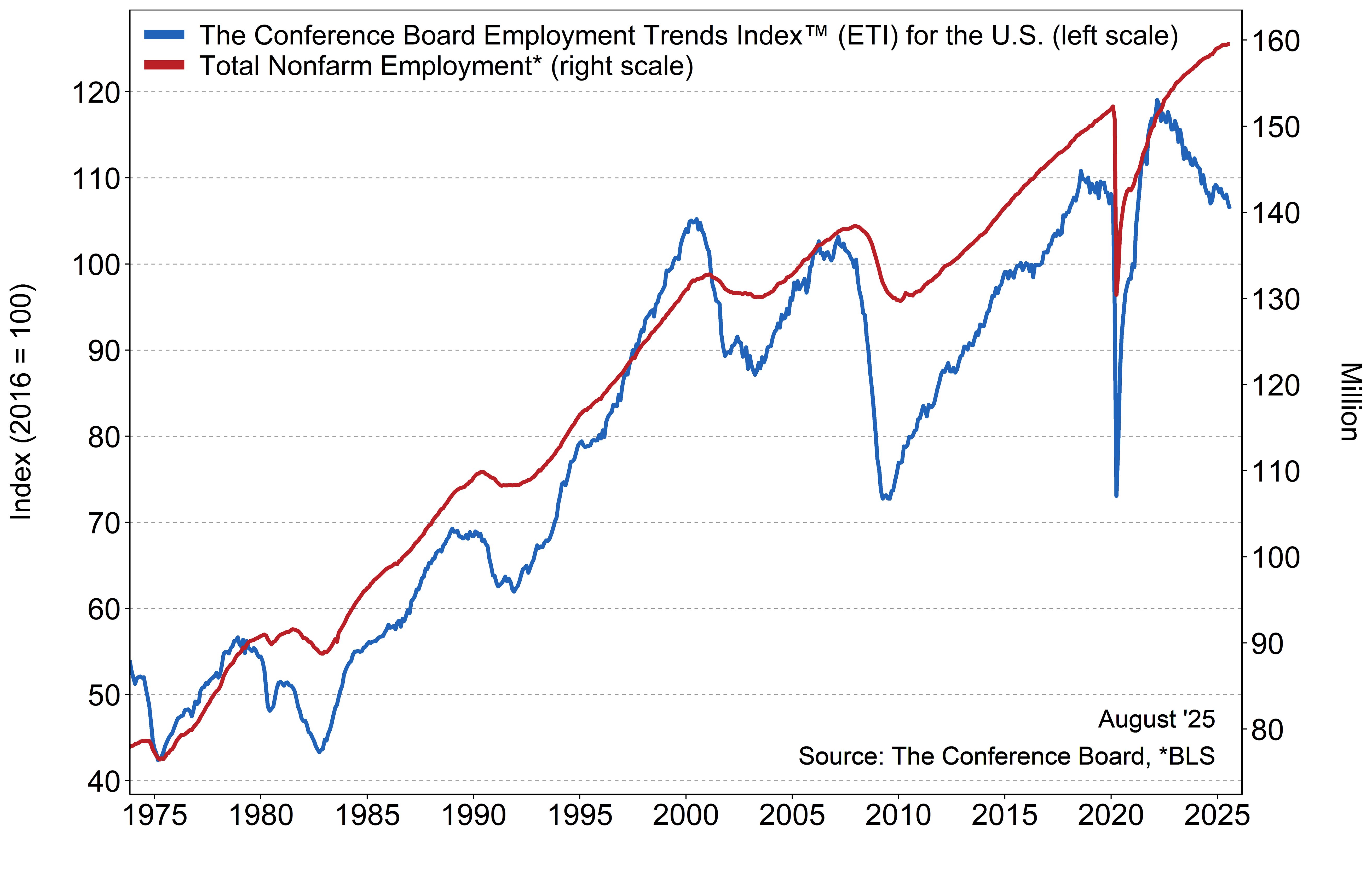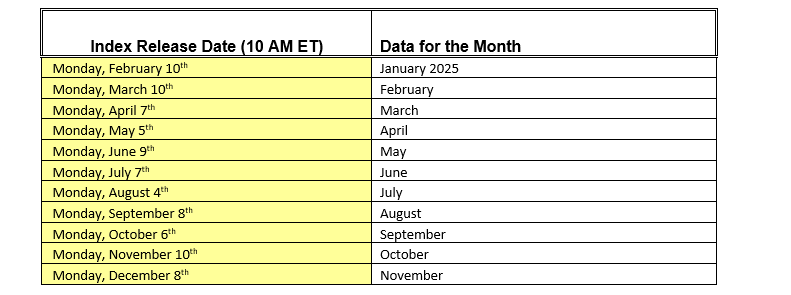An aggregate of eight labor-market indicators that shows underlying trends in employment conditions. Data series: 1973 – present.
The Conference Board Employment Trends Index™ (ETI) Falls in August
Latest Press Release
Updated: Monday, September 8, 2025
Note: Due to the US federal government shutdown, all further releases for The Conference Board Employment Trends Index™ (ETI), The Conference Board−Lightcast Help Wanted OnLine® Index (HWOL Index), The Conference Board Leading Economic Index® of the US (US LEI) and The Conference Board Global Leading Economic Index® (Global LEI) data may be delayed. TCB will resume publication once updated US federal government data are released.
The Conference Board Employment Trends Index™ (ETI) declined in August to 106.41, from a downwardly revised 107.13 in July. An index of 100 equals the 2016 base year and is a relative number. The Employment Trends Index is a leading composite index for payroll employment. When the Index increases, employment is likely to grow as well, and vice versa. Turning points in the Index indicate that a change in the trend of job gains or losses is about to occur in the coming months.
“The ETI slid further in August, reaching its lowest level since early 2021,” said Mitchell Barnes, Economist at The Conference Board. “The ETI peaked two or three years ago and has been falling ever since, where the decline likely captured normalization of the distorted post-pandemic labor market, not weakness. However, the degree of weakness among August’s components is disconcerting.”
The share of consumers who report ‘jobs are hard to get’—an ETI component from the Consumer Confidence Survey®—rose to 20% in August from 18.9% in July, the highest share since early 2021. The share of small firms that report jobs are ‘not able to be filled right now’ fell to 32% in August, down from 33% in July and 36% in June. JOLTS job openings fell by 176,000 in July after falling by 355,000 in June—more than offsetting increases in April and May. Employment in the temporary-help industry also declined, falling by 9,800 in August.
“Layoffs and unemployment remain low as companies navigate through continued uncertainty,” Barnes added. “But tariff pressures are expected to intensify, raising inflation and reducing consumption, which could restrain activity and dampen future hiring.”
Initial claims for unemployment insurance (an ETI component) ticked up slightly in August, returning close to the level last reached in May. The share of involuntary part-time workers was flat in August near 17%, below the high of 18% reached in February. Measures of industrial activity in August contributed the largest negative drag on the ETI since January: Industrial Production fell between June and July, while Real Manufacturing and Trade Sales growth slowed to 3.1% year-over-year in June, from a recent high of 4.6% in March. That slowdown corroborates negative manufacturing survey data, including from the Institute for Supply Chain Management, which reported seven consecutive months of manufacturing employment contraction through August.
“While the labor market remained resilient over much of this year, six of eight ETI components were negative in both July and August for the first time since November 2024. This potentially marks a turning point, where business activity is slowing more materially to reflect softer business confidence levels,” concluded Barnes.
August’s decrease in the Employment Trends Index was a result of negative contributions from six of its eight components: the Percentage of Respondents Who Say They Find ‘Jobs Hard to Get, the Percentage of Firms with Positions Not Able to Fill Right Now, the Number of Employees Hired by the Temporary-Help Industry, Initial Claims for Unemployment Insurance, Real Manufacturing and Trade Sales, and Industrial Production. The two components that contributed positively were Job Openings and the Ratio of Involuntarily Part-time to All Part-time Workers.
The Employment Trends Index aggregates eight leading indicators of employment, each of which has proven accurate in its own area. Aggregating individual indicators into a composite index filters out “noise” to show underlying trends more clearly.
The Conference Board Employment Trends Index ™, November 1973 to Present

The eight leading indicators of employment aggregated into the Employment Trends Index include:
- Percentage of Respondents Who Say They Find “Jobs Hard to Get” (The Conference Board Consumer Confidence Survey®)
- Initial Claims for Unemployment Insurance (U.S. Department of Labor)
- Percentage of Firms with Positions Not Able to Fill Right Now (© National Federation of Independent Business Research Foundation)
- Number of Employees Hired by the Temporary-Help Industry (U.S. Bureau of Labor Statistics)
- Ratio of Involuntarily Part-time to All Part-time Workers (BLS)
- Job Openings (BLS)***
- Industrial Production (Federal Reserve Board)*
- Real Manufacturing and Trade Sales (U.S. Bureau of Economic Analysis)**
*Statistical imputation for the recent month
**Statistical imputation for two most recent months
The Conference Board publishes the Employment Trends Index monthly, at 10 a.m. ET, on the Monday that follows each Friday release of the Bureau of Labor Statistics Employment Situation report. The technical notes to this series are available on The Conference Board website: http://www.conference-board.org/data/eti.cfm.
About The Conference Board
The Conference Board is the member-driven think tank that delivers Trusted Insights for What’s Ahead®. Founded in 1916, we are a non-partisan, not-for-profit entity holding 501 (c) (3) tax-exempt status in the United States. www.conference-board.org.
|
Employment Trends Index (ETI)™ 2025 Publication Schedule |




